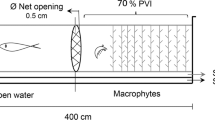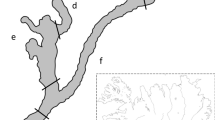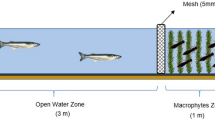Abstract
An enclosure study was conducted in Ranger Lake in south-central Ontario, Canada from 4 July to 5 August 1997 to determine predation effects of the larvae of the phantom midge fly Chaoboruson the zooplankton community. Zooplankton assemblages were established in 12 enclosures (2 m in diameter, 7.5 m deep). Three densities of fourth-instar Chaoborus trivittatus (0 l−1, 0.1 l−1 and 0.5 l−1) were introduced as predator treatments to the enclosures. Temperature, dissolved oxygen and zooplankton community composition were monitored for six weeks. To determine if the zooplankton community composition changed, a repeated measures multivariate analysis was performed on percent biomass of Bosmina and calanoid copepods. There were no significant differences in mean taxon percent biomass among predator treatments. There were significant differences in mean taxon percent biomass between water layers (epilimnion and metalimnion). There were also significant differences in lengths of Bosmina and calanoid copepods among predator treatments at the end of the experiment. Crop content analysis of C. trivittatusshowed that Bosmina constituted 88–98% of the prey items found in the crops. These results demonstrate that the use of deep enclosures, a Chaoborus species which vertically migrates, and lower natural densities of Chaoborus may provide prey with an important natural refuge from predation and so allow a more accurate determination of the predation impact of Chaoborus trivittatusin temperate lakes where fish control Chaoborus densities.
Similar content being viewed by others
References>
Allan, J. D., 1973. Competition and relative abundance of two cladocerans. Ecology 54: 484–498.
Allen, G., N. D. Yan & W. T. Geiling, 1994. ZEBRA 2– Zooplankton enumeration and biomass routines for APIOS – a semi-automated sample processing system for zooplankton ecologists. Ontario Min. Env. Report, Dorset, ON.
Arnott, S. E. & M. J. Vanni, 1993. Zooplankton assemblages in fishless bog lakes: influence of biotic and abiotic factors. Ecology 74: 2361–2380.
Auclair, J. C., J. J. Frenette & J. Dodson, 1993. Zooplankton community structure in southwestern Quebec lakes: the roles of acidity and predation. J. Plankton Res. 15: 1103–1128.
Dodson, S. I., 1972. Mortality in a population of Daphnia rosea. Ecology 53: 1011–1023.
Fedorenko, A. Y., 1975. Feeding characteristics and predation impact of Chaoborus (Diptera, Chaoboridae) larvae in a small lake. Limnol. Oceanogr. 20: 250–258.
Gerritsen, J. & J. R. Strickler, 1977. Encounter probabilities and community structure in zooplankton: a mathematical model. J. Fish Res. Bd Can. 34: 73–82.
Halat, K. M. & J. T. Lehman, 1996. Temperature-dependent energetics of Chaoborus populations: hypothesis for anomalous distributions in the great lakes of East Africa. Hydrobiologia 330: 31–36.
Hambright, K. D., 1994, Morphological constraints in the piscivore–planktivore interaction: implications for the trophic cascade hypothesis. Limnol. Oceanogr. 39: 897–912.
Hanazato, T. A., 1990. Comparison between predation effects on zooplankton communitites by Neomysis and Chaoborus. Hydrobiologia 198: 33–40.
Hanazato, T. & M. Yasuno, 1989. Zooplankton community structure driven by vertebrate and invertebrate predators. Oecologia 81: 450–458.
Kajak, Z. & J. Rybak, 1979. The feeding of Chaoborus flavicans Meigen (Diptera, Chaoboridae) and its predation on lake zooplankton. Int. Revue ges. Hydrobiol. 64: 361–378.
Lewis, W. M., Jr., 1977. Feeding selectivity of a tropical Chaoborus population. Freshwat. Biol. 7: 311–325.
Lewis, W. M., Jr., 1979. Zooplankton Community Analysis: studies on a tropical system. New York: Springer-Verlag.
Lynch, M., 1979. Predation, competition, and zooplankton community structure: An experimental study. Limnol. Oceanogr. 24: 253–272.
Melville, G. E. & E. J. Maly, 1981. Vertical distribution and zooplankton predation in a small temperate pond. Can. J. Zool. 59: 1720–1725.
Neill, W. E., 1981, Impact of Chaoborus predation upon the structure and dynamics of a crustacean zooplankton community. Oecologia 48: 164–177.
Pastorok, R. A., 1980. The effects of predator hunger and food abundance on prey selection by Chaoborus larvae. Limnol. Oceanogr. 25: 910–921.
Pastorok, R. A., 1981. Prey vulnerability and size selection by Chaoborus larvae. Ecology 62: 1311–1324.
Ramcharan, C. W., D. J. McQueen, E. Demers, S. A. Popiel, A. M. Rocchi, N. D. Yan, A. H. Wong & K. D. Hughes, 1995. A comparative approach to determining the role of fish predation in structuring limnetic ecosystems. Arch. Hydrobiol. 133: 389–416.
Riessen, H. P., W. J. O'Brien & B. Loveless, 1984. An analysis of the components of Chaoborus predation on zooplankton and the calculation of relative prey vulnerabilities. Ecology 65: 514–522.
Riessen, H. P.,J. W. Somerville, C. Chiapppari & D. Gustafson, 1988. Chaoborus predation, prey vulnerability and their effect in zooplankton communities. Can. J. Fish. aquat. Sci. 45: 1912–1920.
SAS Institute, Inc., 1990. SAS/STAT user's guide version 6. 4th edn, volume 2. Cary, NC.
Stenson, J. A. E., 1990. Creating conditions for changes in prey community structure by Chaoborus spp. in a lake in Sweden. Hydrobiologia 198: 205–214.
Swift, M. C., 1976. Energetics of vertical migration in Chaoborus trivittatus larvae. Ecology 57: 900–914.
Swift, M. C. & A. Y. Fedorenko, 1975. Some aspects of prey capture by Chaoborus larvae. Limnol. Oceanogr. 20: 418–425.
Thorp, J. H. & H. P. Covich, 1991. Ecology and Classification of North American Freshwater Invertebrates. San Diego: Academic Press.
Von Ende, C. N. & D. O. Dempsey, 1981. Apparent exclusion of the cladoceran Bosmina longirostris by the invertebrate predator Chaoborus americanus. Am. midl. Nat. 105: 240–248.
Wilks, S. S., 1932. Certain generalizations in the analysis of variance. Biometrika 24: 471–494.
Yan, N. D., W. Keller, H. J. MacIsaac & L. J. McEachern, 1991. Regulation of zooplankton community structure of an acidified lake by Chaoborus. Ecol. Appl. 1: 52–65.
Author information
Authors and Affiliations
Rights and permissions
About this article
Cite this article
Sutor, M., Ramcharan, C. & Downer, R.G. Predation effects of two densities of fourth-instar Chaoborus trivittatus on a freshwater zooplankton assemblage. Hydrobiologia 464, 121–131 (2001). https://doi.org/10.1023/A:1013939201391
Issue Date:
DOI: https://doi.org/10.1023/A:1013939201391




